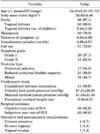1. Coyne KS, Zhou Z, Bhattacharyya SK, Thompson CL, Dhawan R, Versi E. The prevalence of nocturia and its effect on health-related quality of life and sleep in a community sample in the USA. BJU Int. 2003; 92:948–954.
2. Kwon BE, Kim GY, Son YJ, Roh YS, You MA. Quality of life of women with urinary incontinence: a systematic literature review. Int Neurourol J. 2010; 14:133–138.
3. Coyne KS, Zhou Z, Thompson C, Versi E. The impact on health-related quality of life of stress, urge and mixed urinary incontinence. BJU Int. 2003; 92:731–735.
4. Homma Y, Yoshida M, Seki N, Yokoyama O, Kakizaki H, Gotoh M, et al. Symptom assessment tool for overactive bladder syndrome: overactive bladder symptom score. Urology. 2006; 68:318–323.
5. Irwin DE, Milsom I, Hunskaar S, Reilly K, Kopp Z, Herschorn S, et al. Population-based survey of urinary incontinence, overactive bladder, and other lower urinary tract symptoms in five countries: results of the EPIC study. Eur Urol. 2006; 50:1306–1314.
6. Tikkinen KA, Johnson TM II. Epidemiology of nocturia: evaluation of prevalence, incidence, impact and risk factors. In : Weiss JP, Blaivas JG, Van Kerrebroeck PE, Wein AJ, editors. Nocturia. New York: Springer;2012. p. 77–107.
7. Cornu JN, Abrams P, Chapple CR, Dmochowski RR, Lemack GE, Michel MC, et al. A contemporary assessment of nocturia: definition, epidemiology, pathophysiology, and management: a systematic review and meta-analysis. Eur Urol. 2012; 62:877–890.
8. Park HK, Kim HG. Current evaluation and treatment of nocturia. Korean J Urol. 2013; 54:492–498.
9. Morgan TO Jr, Westney OL, McGuire EJ. Pubovaginal sling: 4-year outcome analysis and quality of life assessment. J Urol. 2000; 163:1845–1848.
10. Lee GB, Kim HS, Koh JS, Kim HW, Lee YS, Suh HJ, et al. The changes of storage symptoms after tension-free vaginal tape procedures in stress urinary incontinence patients. Korean J Urol. 2007; 48:1289–1295.
11. Jain P, Jirschele K, Botros SM, Latthe PM. Effectiveness of midurethral slings in mixed urinary incontinence: a systematic review and meta-analysis. Int Urogynecol J. 2011; 22:923–932.
12. Duckett JR, Tamilselvi A. Effect of tension-free vaginal tape in women with a urodynamic diagnosis of idiopathic detrusor overactivity and stress incontinence. BJOG. 2006; 113:30–33.
13. Choe JH, Choo MS, Lee KS. The impact of tension-free vaginal tape on overactive bladder symptoms in women with stress urinary incontinence: significance of detrusor overactivity. J Urol. 2008; 179:214–219.
14. Athanasiou S, Grigoriadis T, Giannoulis G, Protopapas A, Antsaklis A. Midurethral slings for women with urodynamic mixed incontinence: what to expect. Int Urogynecol J. 2013; 24:393–399.
15. Coyne K, Revicki D, Hunt T, Corey R, Stewart W, Bentkover J, et al. Psychometric validation of an overactive bladder symptom and health-related quality of life questionnaire: the OAB-q. Qual Life Res. 2002; 11:563–574.
16. Okamura K, Usami T, Nagahama K, Maruyama S, Mizuta E. "Quality of life" assessment of urination in elderly Japanese men and women with some medical problems using International Prostate Symptom Score and Kings Health Questionnaire. Eur Urol. 2002; 41:411–419.
17. Stamey TA. Endoscopic suspension of the vesical neck for urinary incontinence in females. Report on 203 consecutive patients. Ann Surg. 1980; 192:465–471.
18. van Kerrebroeck P, Abrams P, Chaikin D, Donovan J, Fonda D, Jackson S, et al. The standardisation of terminology in nocturia: report from the Standardisation Sub-committee of the International Continence Society. Neurourol Urodyn. 2002; 21:179–183.
19. van Kerrebroeck P, Andersson KE. Terminology, epidemiology, etiology, and pathophysiology of nocturia. Neurourol Urodyn. 2014; 33:S2–S5.
20. Lee KS, Choo MS, Lee YS, Han JY, Kim JY, Jung BJ, et al. Prospective comparison of the 'inside-out' and 'outside-in' transobturator-tape procedures for the treatment of female stress urinary incontinence. Int Urogynecol J Pelvic Floor Dysfunct. 2008; 19:577–582.
21. Tennstedt SL, Fitzgerald MP, Nager CW, Xu Y, Zimmern P, Kraus S, et al. Quality of life in women with stress urinary incontinence. Int Urogynecol J Pelvic Floor Dysfunct. 2007; 18:543–549.
22. Contreras Ortiz O. Stress urinary incontinence in the gynecological practice. Int J Gynaecol Obstet. 2004; 86:S6–S16.
23. Abdel-Fattah M, Hopper LR, Mostafa A. Evaluation of transobturator tension-free vaginal tapes in the surgical management of mixed urinary incontinence: 3-year outcomes of a randomized controlled trial. J Urol. 2014; 191:114–119.
24. Frick AC, Huang AJ, Van den Eeden SK, Knight SK, Creasman JM, Yang J, et al. Mixed urinary incontinence: greater impact on quality of life. J Urol. 2009; 182:596–600.
25. Ulmsten U, Petros P. Intravaginal slingplasty (IVS): an ambulatory surgical procedure for treatment of female urinary incontinence. Scand J Urol Nephrol. 1995; 29:75–82.
26. Delorme E. Transobturator urethral suspension: mini-invasive procedure in the treatment of stress urinary incontinence in women. Prog Urol. 2001; 11:1306–1313.
27. Tikkinen KA, Tammela TL, Huhtala H, Auvinen A. Is nocturia equally common among men and women? A population based study in Finland. J Urol. 2006; 175:596–600.
28. Tikkinen KA, Johnson TM 2nd, Tammela TL, Sintonen H, Haukka J, Huhtala H, et al. Nocturia frequency, bother, and quality of life: how often is too often? A population-based study in Finland. Eur Urol. 2010; 57:488–496.
29. Takao T, Tsujimura A, Kiuchi H, Takezawa K, Okuda H, Yamamoto K, et al. Correlation between overactive bladder symptoms and quality of life in Japanese male patients: focus on nocturia. Urology. 2013; 82:189–193.
30. Tchey DU, Kim WT, Kim YJ, Yun SJ, Lee SC, Kim WJ. Influence of obesity on short-term surgical outcome of the transobturator tape procedure in patients with stress urinary incontinence. Int Neurourol J. 2010; 14:13–19.









 PDF
PDF ePub
ePub Citation
Citation Print
Print



 XML Download
XML Download